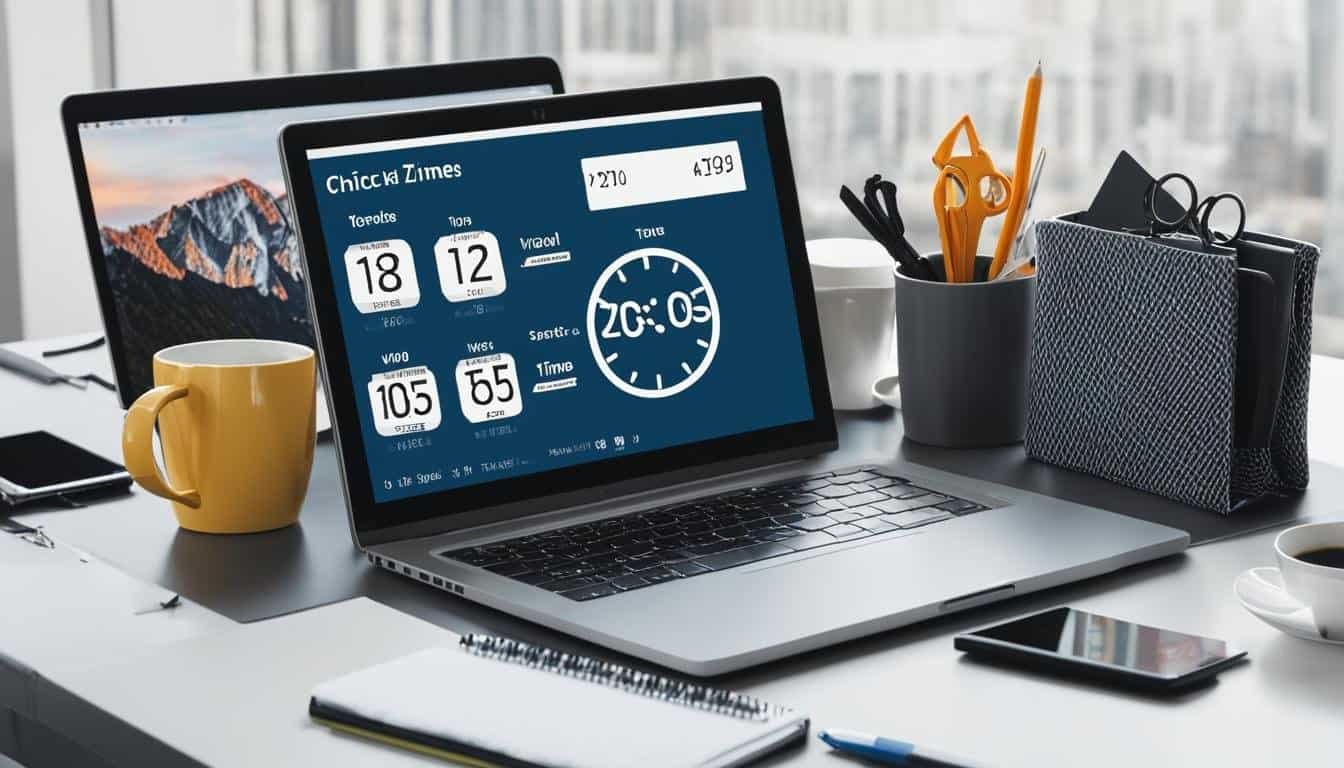Efficient Remote Work Time Management Tips
Working remotely presents unique challenges when it comes to managing time effectively. The lack of a structured office environment and the proximity of distractions can often lead to decreased productivity. However, with the right strategies and mindset, remote workers can master their time management skills and achieve optimal results in their work.
In this article, we will explore various time management tips specifically designed for those working remotely. Whether you are a seasoned remote professional or just starting your remote work journey, these tips will help you stay organized, focused, and productive throughout the day.
Key Takeaways:
- Create a schedule that outlines your work hours and commitments.
- Designate specific spaces in your home for work and leisure.
- Utilize productivity apps to stay organized and track your time.
- Dress professionally to establish a focused work mindset.
- Schedule breaks and free time to recharge and maintain work-life balance.
Plotting Your Schedule
Time management plays a crucial role in the success of remote employees. To effectively manage your time and maximize productivity, it is essential to create a well-structured schedule. Collaborating with your partner or family members can help you establish a schedule that aligns with everyone’s needs and ensures a harmonious work-life balance.
“When everyone in the household knows who will be working where and when, it becomes much easier to coordinate and avoid unnecessary disruptions,” says Sarah Johnson, a remote work expert.
One effective time management strategy for remote employees is the “windowed work” approach. Instead of following a traditional 9-to-5 schedule, you can divide your day into distinct time blocks for different activities. Allocate specific time slots for focused work, meetings, breaks, and personal commitments.
This approach allows you to harness your peak productivity periods and enhances your ability to focus on specific tasks. By clearly defining when you will be working on different activities throughout the day, you can better manage your time and avoid feeling overwhelmed.
Implementing the “Windowed Work” Approach:
- Create a schedule that suits your natural energy levels and personal preferences.
- Communicate your availability and designated work hours with your team and loved ones.
- Block out specific time slots for deep work, meetings, and breaks.
- Include flexibility for unexpected tasks or urgent matters that may arise.
| Time Block | Activities |
|---|---|
| Morning |
|
| Afternoon |
|
| Late Afternoon |
|
By adhering to your planned schedule, you can optimize your time management and productivity. Remember to allocate breaks and downtime to prevent burnout and maintain a healthy work-life balance.
With proper planning and the “windowed work” approach, remote work scheduling can become a powerful tool for enhancing focus, productivity, and overall job satisfaction.
Designating Spaces
In order to enhance your remote work productivity and improve time management for remote teams, it is crucial to designate specific spaces within your home for different activities. By creating a clear distinction between work, leisure time, and other activities, you can mentally focus on each task at hand, increasing your overall efficiency.
Consistency in the spaces you choose for work and play is key to effective time management. Having a designated workspace helps signal to your brain that it’s time to focus and be productive. Similarly, having a separate area for leisure activities can create a boundary between work and relaxation, allowing you to recharge and maintain a healthy work-life balance.
Consider setting up a dedicated home office or designating a specific corner of a room as your work area. This will help minimize distractions and provide a physical space where you can concentrate on your tasks. Optimize your workspace by organizing it in a way that fosters productivity, ensuring all the necessary tools and resources are readily accessible.
“A clutter-free and well-organized workspace can have a positive impact on your focus and productivity.”
When it comes to leisure activities, creating a separate space can help you unwind and recharge. This could be a cozy reading nook, a workout area, or a spot for artistic pursuits. Having designated spaces for leisure signals to your brain that it’s time to relax and engage in enjoyable activities, allowing you to fully recharge and avoid burnout.
By designating spaces for different activities, you create physical boundaries that mimic the separation typically found in a traditional office environment. This helps your brain shift between work mode and relaxation mode, ultimately leading to improved time management and productivity.
Strive to create a productive and inspiring workspace by personalizing it with meaningful decorations, plants, and natural light. Experimenting with different layouts and setups can help you discover what works best for you. Remember, the goal is to create an environment that supports your productivity and well-being.
Exploring Productivity Apps
When it comes to remote work, managing your time effectively is crucial. Thankfully, there are numerous productivity apps and software available that can help you streamline your workflow, meet deadlines, and track your time. By integrating these tools into your daily routine, you can enhance your time management skills and stay on top of your tasks.
The Benefits of Productivity Apps
Productivity apps offer a wide range of features designed to boost your efficiency and organization. These tools can help you:
- Stay organized by creating task lists and setting reminders for important deadlines.
- Track your time accurately, enabling you to monitor how much time you spend on specific tasks and identify areas for improvement.
- Utilize time-tracking features that prompt you to take regular breaks, preventing burnout and promoting better work-life balance.
- Collaborate more effectively with your remote team by sharing files, assigning tasks, and communicating in real-time.
Recommended Productivity Apps
Here are some popular productivity apps that can help you enhance your remote work time management:
| App Name | Description |
|---|---|
| Trello | A flexible project management tool that allows you to create boards, lists, and cards to track your tasks and collaborate with your team. |
| Todoist | A simple yet powerful to-do list app that enables you to create and prioritize tasks, set due dates, and track your progress. |
| RescueTime | This app runs in the background to track the time you spend on different websites and applications, helping you identify productivity gaps and improve your focus. |
| Focus@Will | An instrumental music app designed to boost your productivity by creating a personalized playlist that helps you stay focused and motivated. |
“Productivity is never an accident. It is always the result of a commitment to excellence, intelligent planning, and focused effort.” – Paul J. Meyer
Exploring and integrating the right productivity apps into your remote work routine can have a profound impact on your time management skills. Take the time to experiment with different tools and find the ones that suit your needs best. Remember, the key to effective time management is finding a balance between technology and focused effort.
Dressing for Success
When working remotely, it’s easy to fall into the trap of staying in your pajamas all day. However, dressing as if you were going to the office can have a significant impact on your time management skills and productivity. By treating your remote work like a professional job, you create a routine and mindset for focused work.
When you dress professionally, it signals to your brain that it’s time to get to work. It helps you mentally transition from leisure mode to work mode, allowing you to better manage your time and stay productive throughout the day. Additionally, dressing up can positively impact your self-confidence and motivation, leading to increased efficiency.
Take the time each morning to select an outfit that makes you feel confident and professional. Dressing appropriately can also be helpful for unexpected video meetings or virtual conferences, where your appearance plays a role in making a good impression.
“The way we dress affects how we think, how we feel, how we act, and how others perceive us. Dressing professionally for remote work is not just about appearances; it’s about creating an environment conducive to successful time management.”
Remember that dressing for success doesn’t mean wearing a full business suit at home. Instead, choose clothing that strikes a balance between comfort and professionalism. Opt for smart casual attire that aligns with the expectations of your industry and workplace.
Benefits of Dressing Professionally for Remote Work:
- Enhances focus and productivity
- Keeps you in a professional mindset
- Boosts self-confidence and motivation
- Helps create a clear separation between work and leisure
- Improves your overall time management skills
By dressing for success, you establish a work environment that promotes efficiency, professionalism, and effective time management. Remember, even though you may be working from the comfort of your own home, setting the right tone with your attire can make a world of difference in your productivity.
Treating Free Time like Work Meetings
Schedule breaks and free time on your calendar just like you would schedule work meetings. This simple yet effective strategy can help you optimize your time management skills as a remote worker and enhance your overall productivity.
“Scheduling breaks and free time is crucial for maintaining a healthy work-life balance and preventing burnout,” says Sarah Thompson, a remote work productivity coach. “By treating these periods as important appointments, you prioritize self-care and ensure that you have dedicated time for relaxation and rejuvenation.”
When you schedule breaks and free time on your calendar, it serves as a reminder for you to take regular breaks throughout the day. Taking breaks has been proven to boost concentration and productivity, as well as improve overall well-being. By consciously blocking out time for breaks, you prevent yourself from becoming too engrossed in work and avoid the pitfalls of overworking.
Not only does scheduling breaks benefit you personally, but it also communicates to others that you cannot be disturbed during those times. This helps establish boundaries and sets clear expectations with colleagues, clients, and family members. They will understand that you are unavailable during those scheduled breaks and respect your need for uninterrupted downtime.
During your free time, make it a point to engage in activities that promote relaxation and recharge your energy. Take a walk, practice mindfulness exercises, or enjoy a hobby that brings you joy. Additionally, use your free time to interact with colleagues or family members, either through casual conversations or virtual team-building activities. These social interactions can foster a sense of connection and community, which is especially important for remote workers.
Create Boundaries for Your Free Time
It’s important to establish boundaries around your free time to ensure that it remains uninterrupted. Avoid checking work emails or engaging in work-related tasks during your scheduled breaks. Instead, focus on rejuvenating your mind and body, allowing yourself to fully disconnect from work responsibilities.
By treating your free time with the same level of importance as work meetings, you prioritize self-care and maintain a healthier work-life balance. Remember that taking regular breaks and allowing yourself time to recharge is not a luxury but a necessity for long-term productivity and well-being.
Minimizing Distractions from Social Media
When working remotely, it’s easy to get caught up in the endless scroll of social media feeds, losing precious time and reducing productivity. To improve your remote work time management and maintain focus, take proactive steps to minimize distractions from social media.
Log Out and Disconnect
During your designated work hours, make it a habit to log out of all your social media accounts. By removing the convenience of staying logged in, you create a barrier that reminds you to stay on task and prevents mindless scrolling.
Remove Shortcuts and Use Private Browsing
Avoid the temptation of quick access to social media platforms by removing shortcuts from your web browser. By eliminating their presence, you make it less likely to click and get distracted. Additionally, consider using private browsing modes that don’t save login information, making it more inconvenient to access social media accounts during work hours.
“The secret to mastering time management is to eliminate distractions that prevent us from focusing on our priorities.”
Use these remote work productivity hacks to improve time management for remote teams and increase overall efficiency. With these simple but effective strategies in place, you can minimize distractions from social media and stay focused on the tasks at hand.
Being Transparent with Your Manager
Effective time management in a remote work environment requires open communication and transparency with your manager. By proactively discussing your availability and work hour expectations, you can establish realistic expectations and foster a productive work relationship.
During this conversation, it is important to share any family obligations or commitments that may impact your availability. This allows your manager to understand your unique circumstances and make appropriate accommodations. Additionally, if you find that you are more productive during nontraditional hours, express this preference to your manager, as it can help optimize your work performance.
By openly discussing your availability and preferences, you can work together with your manager to establish a mutually beneficial arrangement that allows you to effectively manage your time and meet your professional goals.
| Benefits of Transparent Communication | Importance of Openness |
|---|---|
|
|
The key is to maintain open lines of communication throughout your time as a remote employee. Regularly updating your manager on your progress and discussing any challenges or changes in your availability ensures that everyone is on the same page and can effectively manage their time.
“Transparency is not about simply sharing your schedule or availability; it’s about fostering a culture of trust and accountability in remote teams.”
By being transparent and maintaining effective communication with your manager, you can establish a productive remote work environment that supports your time management strategies and enables you to thrive in your role.
Setting Boundaries that Work for You
As a remote worker, it’s crucial to establish clear boundaries to mark the end of your workday and separate your personal life from your professional commitments. Here are some helpful remote work scheduling tips to help you effectively manage your time and maintain a healthy work-life balance.
Set Alarms and Physically Disconnect
One simple yet effective way to signal the end of your workday is to set an alarm or reminder on your phone or computer. This will serve as a gentle reminder to wrap up any pending tasks and transition into your personal life. Additionally, physically disconnecting from your work environment can be highly beneficial. Turn off your computer, close work-related apps, and store away your work materials. By doing so, you create a visual and mental separation, allowing you to unwind and recharge.
Communicate Your Work Hours
Make your work hours known to your colleagues and clients by including them in your email signature or setting them as a status message on your communication platforms. This proactive approach will help prevent colleagues from reaching out to you outside of your designated working hours, allowing you to fully disconnect and recharge during your personal time.
Embrace Work-Life Balance
Remember that setting boundaries is not just about signaling the end of your workday; it’s also about creating a healthy work-life balance. Prioritize self-care and make time for activities that bring you joy and relaxation. Whether it’s spending quality time with loved ones, pursuing hobbies, or engaging in exercise, dedicating time to yourself and your personal life is essential for overall well-being and productivity.
Setting boundaries is not a sign of weakness; it’s an act of self-care and self-respect. By establishing clear boundaries, you can protect your personal time and enhance your productivity when you are working.
Creating a Manageable Schedule
When it comes to remote work, effective time management is crucial. By implementing remote work time management techniques, you can optimize your productivity and achieve a healthy work-life balance. Here are some tips to help you create a manageable schedule:
- Polish Your Planning Skills: Begin by organizing your tasks and responsibilities. Consider using project management tools or digital planners to keep track of deadlines, prioritize tasks, and set achievable goals.
- Create a Daily To-Do List: Start each day by outlining the key tasks you need to accomplish. Breaking them down into smaller, manageable tasks will help you stay focused and motivated throughout the day.
- Set Task Priorities: Determine which tasks are most urgent and require immediate attention. By prioritizing your tasks, you can ensure that you allocate sufficient time and resources to complete them effectively.
- Maintain Transparent Communication: Regularly communicate with your manager or team to discuss your workload, progress, and any challenges you may be facing. Transparent communication ensures that everyone is on the same page and can help alleviate potential time management conflicts.
- Learn to Say No: It’s important to recognize your limitations and avoid taking on more tasks than you can handle. Politely declining additional responsibilities when your plate is already full can prevent burnout and allow you to focus on high-priority tasks.
- Eliminate Distractions: Minimize interruptions by creating a distraction-free work environment. Turn off notifications, close unnecessary tabs, and limit distractions to enhance your focus and concentration.
- Avoid Multitasking: While it may seem efficient, multitasking can actually decrease productivity. Instead, focus on one task at a time to maintain clarity and produce high-quality work.
- Embrace Breaks: Taking regular breaks is essential for maintaining productivity and preventing burnout. Use your breaks to relax, recharge, and clear your mind. Engaging in short physical activities or mindfulness exercises can help rejuvenate your energy.
By following these effective time management techniques for remote workers, you can create a schedule that works for you. Remember to adapt these strategies to fit your individual needs and preferences. Embrace the power of effective time management to enhance your productivity and achieve a healthy work-life balance.
Conclusion
Mastering time management skills is crucial for remote workers to optimize their productivity and achieve a healthy work-life balance. By implementing the time management strategies and productivity hacks outlined in this article, remote workers can effectively manage their time and achieve optimal results in their work. It is important to remember that these techniques should be practiced and adapted to suit individual needs and preferences.
Creating a well-thought-out schedule, designating dedicated workspaces, utilizing productivity apps, and setting boundaries are just a few key strategies that remote workers can employ to enhance their time management skills. Additionally, treating free time like work meetings and minimizing distractions such as social media can significantly improve productivity.
By being transparent with their managers about work hour expectations and setting realistic boundaries, remote workers can effectively manage their time and maintain a healthy work-life balance. Embracing breaks, prioritizing tasks, and avoiding multitasking are also essential in ensuring efficient time management.
Ultimately, remote workers have the opportunity to leverage their time and achieve incredible results by employing these time management and productivity hacks. With practice and dedication, remote workers can navigate the challenges of working remotely and maximize their potential.







